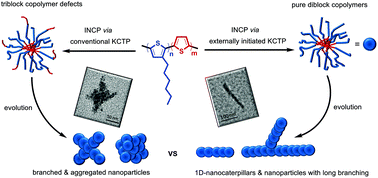Importance of choosing the right polymerization method for in situ preparation of semiconducting nanoparticles from the P3HT block copolymer†
Abstract
The solution-processed self-assembly of conjugated block copolymers has been a useful strategy to produce various semiconducting nanostructures that can provide a pre-organized charge-transporting channel with high charge-carrier mobility. However, previously reported conjugated block copolymer self-assembly methods required post-synthetic treatments such as dialysis, selective solvent additions, temperature modulation, or long-time aging. Moreover, due to the relatively weak driving forces for self-assembly, the resulting nanostructures proved to be fragile when subjected to external stimuli such as heat and mechanical force. To overcome these issues, we have developed a step-economical direct self-assembly process, termed the ‘in situ nanoparticlization of conjugated polymers’ (INCP), which utilizes the extremely strong π–π interactions of insoluble blocks containing a conjugated polymer without side chains to drive the self-assembly. Previously, we successfully demonstrated in situ nanoparticlization of fully conjugated block copolymers containing poly(para-phenylene) and poly(3-(2-ethylhexyl)thiophene) as the shell, but their electronic application was rather limited, mainly because of the low conductivity of the synthesized shell. Thus, to enhance the conductivity of the nanostructures, the most widely used conjugated polymer in the field of organic electronics, poly(3-hexylthiophene) (P3HT), should be introduced to the design of INCP. Herein, we report the formation of various nanostructures from P3HT-b-polythiophene (PT) depending on the polymerization protocols. Initially, INCP via conventional Kumada catalyst-transfer polycondensation (KCTP) produced irregular and highly branched nanostructures. On the other hand, conducting INCP employing a more precise synthesis, externally initiated KCTP, afforded better well-defined nanoparticles such as one-dimensional (1D) rods and long-branching nanoparticles because this method produced diblock copolymers with the highest purity, free from triblock (PT-b-P3HT-b-PT) defects. Overall, in situ self-assembly of P3HT-b-PT provided a simple and step-economical way to produce various semiconducting nanoparticles. In addition, this study reconfirms that precise control of block copolymer synthesis on the molecular level (a first level of control) promotes a more controlled INCP, and its resulting nanostructures (a second level of control).


 Please wait while we load your content...
Please wait while we load your content...